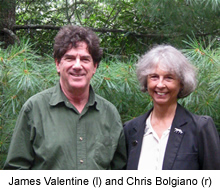The Woods Are Lovely
Photographer James Valentine’s new book captures the fine details of an ancient place
On first glance, Southern Appalachian Celebration looks like a thoughtfully curated collection of gorgeous landscape photos—and it is all. Shots of morning light streaming through the expansive canopy of a hemlock stand can almost put the warmth of the sun on your face, and page-turning becomes the business of imagining the skittish fish just beneath the surface of the cobalt-blue water in an image of Bottom Creek Gorge Preserve. A shot of scattered, stubby red-cedar trees slowly reclaiming a field where a forest once stood tells a story dating back to Daniel Boone’s clearing of the Wilderness Road.
But this is not just a big book filled with pretty pictures. It’s also laced with big ideas that call for bold actions. It’s a book that poses important questions, literally asking its readers to put themselves in the forest’s place when we consider our role as its custodian. One page asks readers to think like a waterway, another to think like a meadow. Despite such sentiments, the book never feels like a hippie tree hug. The combination of Chris Bolgiano’s sober, clear text and James Valentine’s resonant images gives the book a Zen-like stateliness that affirms the seriousness of its intentions without insisting on its own seriousness.
Ultimately, Southern Appalachian Celebration is concerned with how the smallest plants, mushrooms, and soil deposits are interconnected with grand tree strands, rushing rivers, and jagged, sky-carving mountains. Every photograph conveys both realities simultaneously, while also inviting the reader into a dialog with these wondrous spaces.
James Valentine recently answered questions from Chapter 16 via email about photography, ecology, and the preservation of natural spaces
 Chapter 16: These images find their roots in an early experience of yours in the shadows of the southern Appalachians, an experience you have called a “biological awakening.” What do you mean by this phrase?
Chapter 16: These images find their roots in an early experience of yours in the shadows of the southern Appalachians, an experience you have called a “biological awakening.” What do you mean by this phrase?
Valentine: To understand how the soils of the ancient southern Appalachians have been developing for millions of years is truly a biological awakening of how entire “old-growth landscapes” function as a single life form and mutually-supporting unit.
Chapter 16: This book is a true meeting-of-the-minds between dedicated conservationists, but it’s not every outdoorsman or enthusiast who becomes an advocate. What moves people to dedicate themselves to the preservation of a natural place?
Valentine: The book endeavors to connect us with the life-giving ecosystem elements that exist in the forest—the ecosystems that not only keep forests healthy but have provided a healthy environment for us humans in the past and present. Our lives are dependent on a healthy ecosystem, just as we are dependent on a healthy human ecosystem. When you dedicate your life to the preservation of the healthy natural world, you preserve yourself. A win-win combination.
Chapter 16: In the book’s preface you allude to the marvelous names the Cherokee had for places in the area. Care to share a few favorites?
Valentine: The Cherokee refer to Mt. LeConte as “Walasiyi—the place of the large mythical frog.” “Shining Rock” is where the Creator chose to put Kanati and Selu, the first man and woman, according to Cherokee legend.
 Chapter 16: Although most of your images offer wide shots and broad vistas, your preface provides vivid details about the microcosmic universes that exist within the larger Appalachian forests. Does your awareness of these very tiny goings-on at all inform the way you shoot the larger landscape?
Chapter 16: Although most of your images offer wide shots and broad vistas, your preface provides vivid details about the microcosmic universes that exist within the larger Appalachian forests. Does your awareness of these very tiny goings-on at all inform the way you shoot the larger landscape?
Valentine: The smaller world controls the life span of the forests; therefore, I see the large landscapes as an extension of the microscopic world. Also, I look at the large landscapes as [examples of the way] light interacts in all its infinite forms and again plays a role in the health of the forest. “The planet is one large sacred biological art form that expresses itself in trillions of intertwined ways”—one of my favorite sayings!
Chapter 16: The book is divided into sections such as “Thinking Like a Forest” and “Thinking Like a Mountain.” What is your intention with this unusual framing device?
Valentine: The book is an extension of Aldo Leopold’s classic essay “Thinking Like A Mountain.” As Bob Zahner explained in his Introduction, “An appropriate choice, as it conveys the consequences of man’s intrusion on biotic communities. To think like a mountain means to consider the needs of all the plants and animals that make the mountain their home, including rain, air, streams, soil, humus, and microorganisms.” My intention was to have you look inside yourself as you explored this “unusual framing device.”
Chapter 16: Did the sections arise from the photos, or did you set out to capture images that worked best within structures you’d already decided on?
Valentine: Actually both—the book was photographed with the chapter headings in mind and [includes] selections from three decades of work.
Chapter 16: Tell us about J. Manson Valentine, your father. How is this book also his?
Valentine: I feel he was one of the major guiding factors in the vision behind the book. His unending quest to discover the scientific-biological function of nature always included a sacred respect and viewpoint about nature. What a profound and joyful vision, for a scientist to live and die by that evolutionary philosoph





